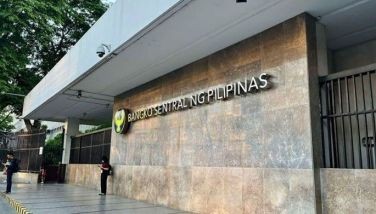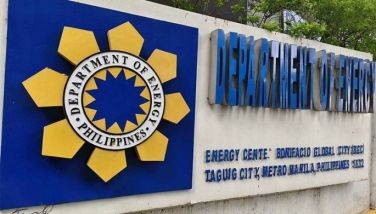ADB cites RP’s Medium-Term Development Plan
April 10, 2005 | 12:00am
The Asian Development Bank (ADB) has cited the significant improvement in the Philippine government’s planning and budgeting linkage through the 2004-2010 Medium-Term Philippine Development Plan (MTPDP), the country’s economic blueprint.
In its draft Country Strategy and Program (CSP), the ADB said the Philippine government’s efforts at enhancing its planning and budgeting linkage, specifically through the MTPDP, establishes a new paradigm for development planning.
"Programs identified in the new MTPDP have been fleshed out in greater detail as specific projects in its accompanying document, the 2005-2010 Medium-Term Public Investment Program (MTPIP), have already been prepared," Socioeconomic Planning Secretary Romulo L. Neri said.
He said the new ADB draft CSP report clearly contradicts some reports criticizing the alleged weak link between the government’s economic plan and budget allocation, particularly referring to the MTPDP and the MTPIP as mere wish lists of programs and projects that departments and agencies may propose for funding.
The World Bank made the assessment three years ago as contained in its report released in 2002, clearly referring to the previous MTPDP and MTPIP.
"The new economic blueprint reflects the government’s commitments and efforts to go beyond policy formulation in development planning," Neri pointed out.
Neri, the director general of the National Economic and Development Authority (NEDA), noted that the MTPDP Strategy
Planning Matrices (SPMs), an accompanying document to the 2004-2010 MTPDP, is expected to answer issues and concerns on ‘when the plans will be deliverable’.
"It actually identifies the various development concerns where government must actively intervene, the manner of intervention as well as the timetable and outputs that must be met," he explained.
Moreover, the 2005-2010 MTPIP translates the goals and policy thrusts drawn up in the 2004-2010 MTPDP, particularly President Arroyo’s 10-point agenda, into a priority set of programs and projects (PAPs).
More specifically, the PAPs are anchored on the SPMs that lay out the specific targets of the MTPDP.
"The MTPIP therefore lists the PAPs with corresponding MTPDP priority strategies and activities they are supporting or linked to annual measurable output targets, and investment requirements/cost estimates over the MTPIP period," Neri added.
The MTPIP is regularly updated per annual budgetary process and agency/corporation performance, reflecting changes in the economic and financial macro parameters and attainment of MTPDP-SPMs’ targets. It also incorporates changes in status of preparedness of those projects proposed or in the pipeline.
"With the strategies and possible funding sources clearly identified in the MTPIP and SPMs, how can it [2004-2010 MTPDP] be a mere wish list?," Neri said.
Neri cited other development partners like World Bank, which has also been supportive of the Philippine government’s development priorities as contained in their Country Assistance Strategy (CAS) 2005-2009 for the Philippines.
Both the ADB’s CSP and the WB’s CAS are designed to revitalize and enhance the quality of the banks’ development partnership with the Philippines.
The NEDA chief also cited the commitment of support to the MTPDP by various sectors of the society, such as the different business groups, local government units and, more recently, the state universities and colleges in the regions.
In its draft Country Strategy and Program (CSP), the ADB said the Philippine government’s efforts at enhancing its planning and budgeting linkage, specifically through the MTPDP, establishes a new paradigm for development planning.
"Programs identified in the new MTPDP have been fleshed out in greater detail as specific projects in its accompanying document, the 2005-2010 Medium-Term Public Investment Program (MTPIP), have already been prepared," Socioeconomic Planning Secretary Romulo L. Neri said.
He said the new ADB draft CSP report clearly contradicts some reports criticizing the alleged weak link between the government’s economic plan and budget allocation, particularly referring to the MTPDP and the MTPIP as mere wish lists of programs and projects that departments and agencies may propose for funding.
The World Bank made the assessment three years ago as contained in its report released in 2002, clearly referring to the previous MTPDP and MTPIP.
"The new economic blueprint reflects the government’s commitments and efforts to go beyond policy formulation in development planning," Neri pointed out.
Neri, the director general of the National Economic and Development Authority (NEDA), noted that the MTPDP Strategy
Planning Matrices (SPMs), an accompanying document to the 2004-2010 MTPDP, is expected to answer issues and concerns on ‘when the plans will be deliverable’.
"It actually identifies the various development concerns where government must actively intervene, the manner of intervention as well as the timetable and outputs that must be met," he explained.
Moreover, the 2005-2010 MTPIP translates the goals and policy thrusts drawn up in the 2004-2010 MTPDP, particularly President Arroyo’s 10-point agenda, into a priority set of programs and projects (PAPs).
More specifically, the PAPs are anchored on the SPMs that lay out the specific targets of the MTPDP.
"The MTPIP therefore lists the PAPs with corresponding MTPDP priority strategies and activities they are supporting or linked to annual measurable output targets, and investment requirements/cost estimates over the MTPIP period," Neri added.
The MTPIP is regularly updated per annual budgetary process and agency/corporation performance, reflecting changes in the economic and financial macro parameters and attainment of MTPDP-SPMs’ targets. It also incorporates changes in status of preparedness of those projects proposed or in the pipeline.
"With the strategies and possible funding sources clearly identified in the MTPIP and SPMs, how can it [2004-2010 MTPDP] be a mere wish list?," Neri said.
Neri cited other development partners like World Bank, which has also been supportive of the Philippine government’s development priorities as contained in their Country Assistance Strategy (CAS) 2005-2009 for the Philippines.
Both the ADB’s CSP and the WB’s CAS are designed to revitalize and enhance the quality of the banks’ development partnership with the Philippines.
The NEDA chief also cited the commitment of support to the MTPDP by various sectors of the society, such as the different business groups, local government units and, more recently, the state universities and colleges in the regions.
BrandSpace Articles
<
>
- Latest
- Trending
Trending
Latest

























